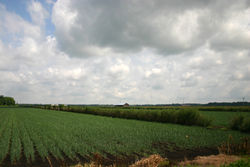Onion
2007 Schools Wikipedia Selection. Related subjects: Food and agriculture
| iOnion | ||||||||||||||
|---|---|---|---|---|---|---|---|---|---|---|---|---|---|---|
 Onions
|
||||||||||||||
| Scientific classification | ||||||||||||||
|
||||||||||||||
|
|
||||||||||||||
| Allium cepa L. |
Onion in the general sense can be used for any plant in the genus Allium but used without qualifiers usually means Allium cepa, also called the garden onion. Onions (usually but not exclusively the bulbs) are edible with a distinctive strong flavour and pungent odour which is mellowed and sweetened by cooking. They generally have a papery outer skin over a fleshy, layered inner core. Used worldwide for culinary purposes, they come in a wide variety of forms and colours.
Onions may be grown from seed or very commonly from "sets". Onion sets are produced by sowing seed very thickly one year, resulting in stunted plants which produce very small bulbs. These bulbs are very easy to set out and grow into mature bulbs the following year, but they have the reputation of producing a less durable bulb than onions grown directly from seed and thinned.
Either planting method may be used to produce spring onions or green onions, which are just onions harvested while immature, although "green onion" is also a common name for the Welsh onion, Allium fistulosum which never produces dry bulbs.
Onions are frequently used in school science laboratories because they have particularly large cells which are easily visible even through rather low-end optical microscopes.
History
It is thought that bulbs from the onion family have been utilised as a food source for millennia. In Palestinian Bronze Age settlements, traces of onion remains were found alongside fig and date stones dating back to 5000 BC. It would be pure conjecture to suggest these were cultivated onions. The archaeological and literary evidence suggests cultivation probably took place around two thousand years later in ancient Egypt. This happened alongside the cultivation of leeks and garlic and it is thought that workers who built the pyramids were fed radishes and onions.
The onion is easily grown, transportable, and has good storage qualities. Egyptians worshipped it, believing that its spherical shape and concentric rings symbolized eternal life. Onions were even used in Egyptian burials as evidenced by onion traces being found in the eye sockets of Ramesses IV. They believed that if buried with the dead, the strong scent of onions would bring breath back to the dead. The onion then made its way to Greece where athletes ate large quantities of onion because it would lighten the balance of blood. Roman gladiators were also rubbed down with onion to firm up their muscles. In the Middle Ages onions were such an important food that people would pay for their rent with onions and even give onions as gifts. Doctors were also known to prescribe onions to end headaches, snakebites and hair loss. The onion was introduced to North America by Christopher Columbus on his 1493 expedition to Haiti.
Onions are a fundamental part of much Indian cooking and are called Pyaaz in Hindi. It is a staple food in India, both due to its use as a common base for curries and as the cheapest and most widely available vegetable for the poor.
Onions are available in fresh, frozen, canned, and dehydrated forms. Onions can be used, usually chopped or sliced, in almost every type of food, including cooked foods and fresh salads, and as a spicy garnish; they are rarely eaten on their own but usually act as accompaniment to the main course.
Depending on the variety, an onion can be sharp and pungent or mild and even sweet.
They appear to be at least somewhat effective against colds, heart disease, diabetes, osteoporosis, and other diseases and contain anti-inflammatory, anticholesterol, anticancer, and antioxidant components such as quercetin.
In many parts of the undeveloped world, onions are used to heal blisters and boils. In the United States, products that contain onion extract (such as Mederma) are used in the treatment of topical scars.
Onions and crying
As onions are sliced, cells are broken open. Onion cells have two sections, one with enzymes called alliinases, the other with sulfides ( amino acid sulphoxides). The enzymes break down the sulphides and generate sulphenic acids. Sulphenic acids are unstable and decompose into a volatile gas called syn-propanethial-S-oxide. The gas then dissipates through the air and eventually reaches one's eye, where it will react with the water to form a dilute solution of sulphuric acid. The sulphuric acid irritates the nerve endings in the eyes, making them sting. The tear glands then produce tears to dilute and flush out the irritant.
A firm in Toronto, Canada, attempted to utilize this property of onions in the manufacture of a form of tear gas for civilian use. It was marketed in 1991 but was unsuccessful as it had an effective shelf life of only three months.
Supplying ample water to the reaction prevents the gas from reaching the eyes. Therefore cutting the onions under running tap water or completely under water can help, as can rinsing the onion and leaving it wet while cutting. Chilling the onion will prevent the enzymes from activating, which will limit the amount of gas generated. Some people will freeze their knives to enhance this effect. Finally, using a sharp knife will limit the cell damage, and therefore prevent the release of enzymes.
Different species of onions will release different amounts of sulphenic acids, thus some will cause more tear formation and irritation than others.
The characteristic odour of onions can be removed with lemon.
Types of onion (Allium cepa)
- Bulb onions - Grown from seed (or onion sets), bulb onions range from the pungent varieties used for dried soups and onion powder to the mild and hearty Sweet onions, such as the Vidalia from Georgia or Walla Walla from Washington that can be sliced and eaten on a sandwich instead of meat.
- Multiplier onions - Raised from bulbs which produce multiple shoots, each of which forms a bulb.
- Shallot (most of the types in the markets are Allium cepa)
- Potato onion
- Tree onions or Egyptian onions - These produce bulblets in the flower head, and are the result of hybridisation between Allium cepa and welsh onions.
Related species
The genus Allium is a large one, and most of the species are considered to be "onions" in the looser sense. Commonly raised vegetable alliums include the leeks, garlic, elephant garlic, chives, shallots, Welsh onions and Chinese chives. There are also species, such as Allium moly, grown for ornament.
Several species of Allium, including A. canadense and A. diabolense, can be collected in the wild and their leaves and bulbs used as food.
In Language
In the English vernacular, "an onion" is a difficult situation, the use stemming from the onion's tendency to irritate or inflame the eyes. Conversely, the term "onion" can be used to describe any state of being, as in the phrase, "[someone] really dices my onion!"



